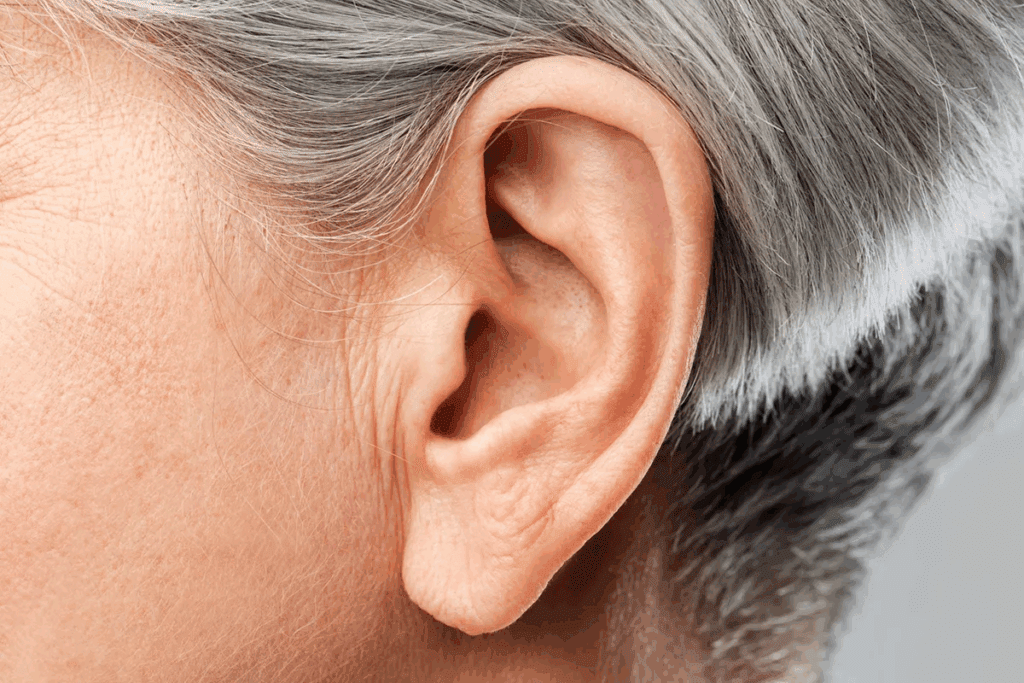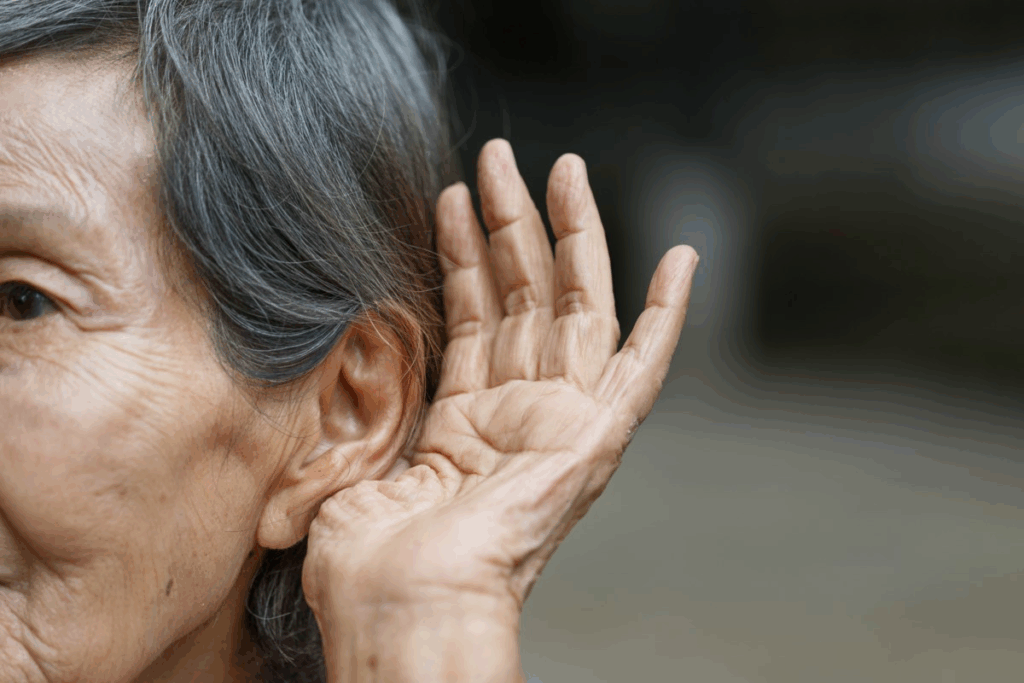Last Updated on October 31, 2025 by Saadet Demir

Does ear infection cause headache? Learn why inflammation and localized pressure often lead to headaches and discomfort.
Ear infections can cause a lot of pain, not just in the ear. They can also lead to debilitating headaches and nausea. At Liv Hospital, we focus on your health and well-being.
When germs infect the middle ear, it gets inflamed and fills with fluid. This causes pain that can spread to your head. The trigeminal nerve is key in this process, making the pain worse.
We know it’s important to understand why you’re feeling this way. Our team works hard to find the right treatment for you.

Ear infections can affect different parts of the ear, each with its own symptoms. The ear is divided into three main parts: the outer ear, middle ear, and inner ear. Infections can happen in any of these areas.
We will look at the different types of ear infections. We will see what makes them unique and how they impact the ear.
Outer ear infections, or otitis externa, happen when the outer ear canal gets infected. They are often caused by water, physical damage, or too much earwax. Symptoms include itching, redness, and discomfort in the outer ear, along with discharge or a feeling of fullness.
Key characteristics of otitis externa include:
Middle ear infections, or otitis media, are more common, mainly in children. They happen when the middle ear gets infected, often from a cold or flu. This can cause fluid buildup, leading to pain, hearing loss, and fever.
Common symptoms of otitis media include:
Inner ear infections, like labyrinthitis and vestibular neuritis, affect the inner ear. They can cause vertigo, nausea, and hearing loss. Labyrinthitis is an inflammation of the inner ear, while vestibular neuritis affects the nerve that controls balance.
The following table summarizes the key differences between the types of ear infections:
Type of Ear Infection | Common Causes | Symptoms |
Otitis Externa | Water exposure, physical damage | Itching, redness, discharge |
Otitis Media | Cold, flu | Ear pain, fever, hearing loss |
Labyrinthitis and Vestibular Neuritis | Viral infections | Vertigo, nausea, hearing loss |

Ear infections can start a chain of events that leads to headaches. We’ll look at how pressure and inflammation play a part in this. These factors are key in causing headaches.
Ear infections cause fluid to build up, leading to pressure. This pressure can spread to the head, causing pain. The Eustachian tube helps control ear pressure. When it’s blocked by infection, it can cause headaches.
Inflammation from an ear infection also triggers headaches. The infection releases chemicals that cause pain and swelling. This can affect nerves, including the trigeminal nerve, leading to headaches.
Medical research has shown a strong link between ear infections and headaches. This means ear infections can affect more than just the ear. They can also cause headaches.
Many studies have looked into how ear infections and headaches are connected. They found that the swelling and pressure from ear infections can cause headaches. For example, a study found that treating ear infections greatly reduced headache symptoms in patients.
“There’s a clear link between ear infections and headaches, mainly in kids,” says a top researcher. This shows why doctors should think about ear infections when treating headaches.
Ear infections and headaches happen more in some age groups than others. Kids are hit hard because of their body shape and growing immune systems. Ear infections are a top reason for kids to see doctors, and many of them get headaches too.
Knowing how common ear infection headaches are in different ages helps doctors treat patients better. They can focus on what each age group needs.
Ear infections can cause severe headaches. Knowing how they connect can help us understand the pain better. We’ll look into how ear infections lead to headaches through specific body pathways.
The trigeminal nerve is key in feeling sensations on the face and scalp. It links ear pain to headaches. This nerve sends signals from the face to the brain, causing pain in the head.
An ear infection can irritate this nerve. This irritation sends pain signals to the brain. As a result, pain is felt in places other than where it started.
Referred pain happens when pain is felt in a different spot than where it started. Ear infections can cause headaches by sending pain signals to the head. The trigeminal nerve’s wide reach helps in this process.
Here’s a table showing where pain from ear infections can be felt:
Source of Pain | Referred Pain Location |
Ear Infection | Temple Area |
Middle Ear | Behind the Ear |
Inner Ear | Vertex (Top of the Head) |
Knowing these pain patterns is key to treating headaches caused by ear infections.
To understand the connection between ear infections and nausea, we need to look at the vestibular system. Ear infections, mainly those in the inner ear, can mess with our balance. This can cause nausea and vomiting.
An ear infection can cause inflammation and fluid buildup in the inner ear. This affects the vestibular system, which helps us balance and stay oriented. People with ear infections might feel nauseous and vomit, like those with motion sickness.
The inflammation from an ear infection can irritate the nerves in the inner ear. This sends mixed signals to the brain about our body’s position and movement. This mix-up can make us feel dizzy and nauseous.
“The vestibular system plays a key role in keeping us balanced. When it’s disrupted by an ear infection, we can experience symptoms like nausea and vomiting.”
The vestibular system is a complex part of the inner ear. It includes the otolith organs and the semicircular canals. These parts work together to sense changes in head position and movement. They help us stay balanced.
Vestibular System Component | Function |
Otolith Organs | Detect linear acceleration and gravity |
Semicircular Canals | Detect rotational movements |
When an ear infection hits the vestibular system, it can mess up its normal function. This leads to balance issues and nausea. Knowing this helps us diagnose and treat ear infection-related nausea better.
Labyrinthitis and other inner ear conditions can really affect your life. They cause a lot of uncomfortable symptoms. The inner ear is key for hearing and balance. When it gets infected or inflamed, it can make life hard.
Labyrinthitis and vestibular neuritis have similar symptoms. These include:
These symptoms are like motion sickness. They make simple tasks hard. Knowing about these symptoms helps doctors treat you right.
Labyrinthitis and vestibular neuritis symptoms are like motion sickness. The inner ear plays a big part in balance. When it’s sick, it can confuse your brain, leading to:
“The dizziness and nausea from inner ear infections are as bad as motion sickness. They really mess up your day.”
It’s important to see these symptoms as signs of inner ear problems, not just motion sickness. We’ll talk about treatments later. But first, we need to fix the infection or inflammation to feel better.
In short, labyrinthitis and other inner ear issues can cause a lot of problems. Symptoms like vertigo, nausea, and hearing loss are common. Knowing about these symptoms helps doctors help you feel better.
Children are more likely to get ear infections because of their body shape and growing immune system. Their Eustachian tube is shorter and more horizontal, making it easier for germs to get in. Also, their immune system is not fully grown, making them more prone to infections.
Several factors make children more likely to get ear infections. These include:
It can be hard to tell if a young child has an ear infection. They might not be able to say how they feel. Look for signs like:
Headaches from ear infections might show up as irritability or fussiness in kids. It’s important for parents and caregivers to watch for these signs and get medical help if needed.
Ear infections can really affect a child’s life, including their school work and daily activities. Problems with hearing can make it hard to follow instructions or talk to friends. It can also make them tired because they can’t sleep well.
We know how important it is to catch and treat ear infections early. This helps keep children’s lives as normal as possible. By understanding ear infections in kids, we can all help them get better care.
Ear infections with headaches and nausea need a detailed check-up. It’s key to spot ear infections right, even with headaches and nausea. This ensures the right treatment.
Checking for ear infections starts with a close look. We use otoscopy to see the ear canal and eardrum. This helps find signs of infection like redness or fluid.
More tests might be needed to be sure. This helps rule out other problems.
Some tests we use are:
It’s hard to tell ear infections from other problems like migraines. Migraines can cause bad headaches and nausea. But they’re not the same as ear infections. We look at the patient’s symptoms and history to figure it out.
To tell them apart, we look at:
By using what we find in the exam and tests, we can find ear infections. Then, we can plan the right treatment.
Ear infections, headaches, and nausea can be very tough to deal with. It’s important to know the treatment options to manage these symptoms well. A good treatment plan helps reduce pain and treats the infection.
For bacterial ear infections, antibiotics are often prescribed. The right antibiotic depends on the infection’s severity and the patient’s health history. It’s key to finish all antibiotics to get rid of the infection.
We also look at other treatments like anti-inflammatory medications to lessen swelling and pain. Sometimes, ear drops are suggested to help with symptoms.
Managing pain is a big part of treating ear infections. Over-the-counter pain relievers, like acetaminophen or ibuprofen, help with headaches and ear pain. For severe pain, doctors might prescribe stronger pain meds.
“Effective pain management is key to improving the quality of life for patients with ear infections.”
Nausea and vomiting can be hard to handle. Anti-nausea medications might be given to help. Drinking plenty of water and eating well can also help with nausea.
If nausea and vomiting don’t go away, it’s important to see a doctor. This helps avoid dehydration and ensures you get the nutrients you need.
Knowing the treatment options helps patients manage their symptoms better. This way, they can recover more effectively from ear infections that cause headaches and nausea.
Home remedies and self-care are key in easing ear infection pain. They offer relief alongside medical treatment. This helps improve comfort and speeds up recovery.
Managing pain is vital when you have an ear infection. Adults can use over-the-counter pain relievers like acetaminophen or ibuprofen. But, always follow the dosage and talk to a doctor, if you can.
For kids, pain relief is more careful. Always check with a pediatrician before giving any medicine. A warm, damp cloth on the ear can also help. Make sure it’s not too hot to avoid burns.
Nausea often comes with ear infections, mainly inner ear ones. Drinking lots of water or clear broths helps keep your body balanced. This is key to feeling better.
Resting in a comfy position can also help. Sitting up or lying on your side might make a big difference. Some people find ginger tea or ginger ale soothing. But, always talk to a doctor before trying new remedies, even for kids.
Using these home remedies and self-care tips can help manage ear infection symptoms. This makes you feel better and can help you recover faster.
Ear infections are common but can be prevented. The right lifestyle modifications and preventive measures can help. These steps can lower the chance of ear infections and symptoms like headaches and nausea.
Changing your lifestyle can help prevent ear infections. Avoiding tobacco smoke is key, as it increases the risk. Also, staying up to date with vaccinations can prevent infections that might lead to ear infections.
Good ear hygiene is also important. Don’t put objects in your ears, as this can push earwax in and cause infections. Clean the outer ear with a washcloth and let the ear canal clean itself naturally.
If you often get ear infections, there are extra steps you can take. Wearing ear protection when bathing or swimming keeps water out. Also, quickly managing allergies and colds can help prevent ear infections.
Seeing a healthcare provider for advice is a good idea. They might suggest ear tubes or other treatments based on your needs.
By making these lifestyle modifications and taking preventive measures, you can lower your risk of ear infections. This can also reduce symptoms like headaches and nausea, improving your life quality.
Ear infections can cause headaches and nausea. This happens through several ways. Knowing about outer, middle, and inner ear infections helps in treating these symptoms.
The link between ear infections and headaches comes from pressure and inflammation. This can cause pain in the head.
Ear infections, mainly in kids, can really affect daily life. It’s important to know the signs, like headaches and nausea. This helps in getting the right medical help.
Prevention and treatment can help manage symptoms. Making lifestyle changes and using medical treatments can make a big difference. This reduces the risk of more serious problems.
Knowing ear infections can lead to headaches and nausea helps in managing them. There are effective treatments for these conditions. They improve your overall health.
If you’re dealing with ongoing or severe symptoms, see a doctor. They can guide you on the best treatment and prevention steps.
Yes, ear infections can lead to headaches and nausea. This is more likely if the infection affects the inner ear or causes a lot of pressure buildup.
Ear infections can cause headaches because of the pressure and inflammation. This can affect the trigeminal nerve. It can then send pain from the ear to the head.
Yes, middle ear infections can cause headaches. This is because of the pressure and inflammation they cause. These symptoms can spread to the head.
Inner ear infections, like labyrinthitis and vestibular neuritis, can cause vertigo and nausea. They can also cause vomiting, hearing loss, and problems with balance.
Yes, inner ear infections can cause nausea and vomiting. This is because they disrupt the vestibular system.
To diagnose ear infections, doctors do a thorough physical exam. This includes otoscopy. They might also do more tests to rule out other conditions.
Treatment includes antibiotics to clear the infection. Doctors also use pain management strategies. They help with nausea and vomiting too.
Yes, home remedies can help. Safe pain relief methods and ways to reduce nausea can make you feel better. They can also help with recovery.
To prevent ear infections, make lifestyle changes. Avoid tobacco smoke and keep vaccinations up to date.
Yes, children are more at risk. This is because their Eustachian tubes are narrower. Their immune systems are also developing.
Yes, ear infections can cause a lot of discomfort. They can disrupt school and daily activities, even more so in children.
Not always, but ear infections can cause headaches. This is more likely if there’s a lot of pressure buildup or inflammation.
Yes, inner ear infections can cause nausea and vomiting. This is because they disrupt the vestibular system.
Yes, ear infections, including those affecting the inner ear, can cause nausea. This is because they disrupt the vestibular system.
Government Health Resource. (2025). Can an Ear Infection Cause Headaches and Nausea. Retrieved from https://www.loyolamedicine.org/press-releases/ear-infections-can-lead-neurological-complications
Subscribe to our e-newsletter to stay informed about the latest innovations in the world of health and exclusive offers!
WhatsApp us